development of firearms
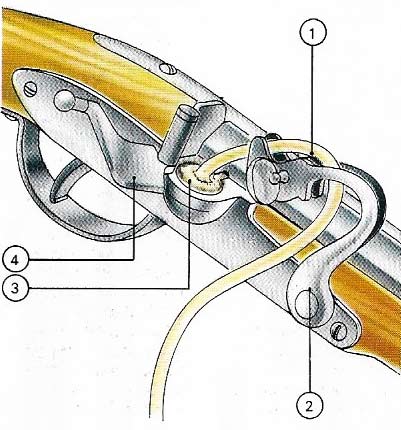
Figure 1. The matchlock mechanism was introduced in the late 15th century. A slow-burning match (1) was secured in a serpentine cock (2) which, when the trigger was pressed, brought the match down on to the powder in the pan (3). A pan-cover (4) kept the powder dry and retained it in the pan when the arm was not in use. The lock shown here is typical of those used from the early 17th century and became common on infantry firearms. The mechanism was too cumbersome to adapt for a pistol or handgun, but it was used on the petronel, a carbine with a short, curved butt, intended for use by horsemen.

Fig 2. Matchlocks of this type were in use in Europe as the common infantry firearm throughout the 17th century. Musketeers protected from the enemy by pikemen, performed the intricate, lengthy drill of loading and firing the massive weapons. Weighing as much as 11 kilograms (25 pounds), these muskets required a forked support to enable soldiers to aim and fire them accurately.
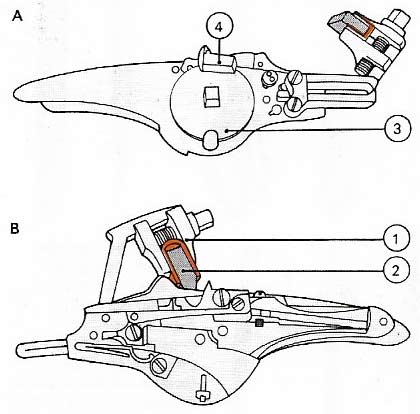
Figure 3. The wheel-lock is shown here externally (A) and internally (B). Most had to be pre-wound with a key. To ignite the charge the dog (1) holding iron pyrites (2) was lowered into contact with the serrated edge of a steel wheel (3) projecting through the bottom of the pan (4). Pressure on the trigger released the wheel, causing a shower of sparks that ignited the priming, which fired the main charge.

Figure 4. Made in southern Germany about 1540, this carbine probably belonged to a rich man. At that time wheel-locks were extremely expensive and usually beautifully decorated. Repairs were also costly.

Figure 5. This military pistol of the mid-17th century is similar to the weapons used by the Cromwellian cavalry and other European armies. A trooper with two such pistols had great firepower.
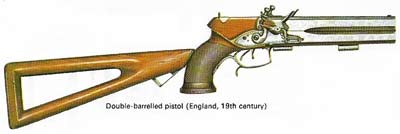
Figure 6. The flintlock in a late form is shown in this officers' pistol. It is equipped with a detachable shoulder stock.

Figure 7. The Kentucky rifle was a notably accurate flintlock firearm. Believed to have evolved from the Jaeger rifle introduced to America by German colonists, it was developed in Pennsylvania and used widely in the Appalachians. The hinged box cut into the butt carried patches to wrap around the bullet before it was rammed down the muzzle.
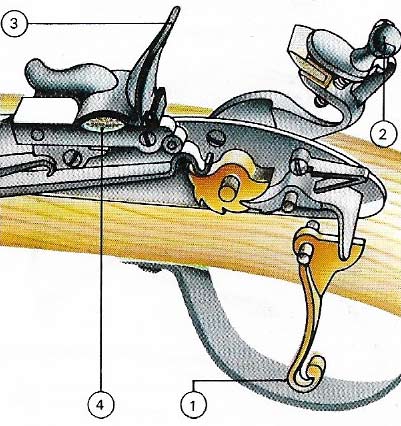
Figure 8. The flintlock was developed in the early seventeenth century. Pulling the trigger (1) released the cock (2) that held a flint. This struck against the battery or steel (3) forcing it back to expose the flashpan (4), and creating a shower of sparks that fell into the priming and ignited it.
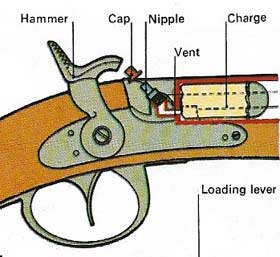
Figure 9. Percussion-cap priming introduced a new reliability to firearms. It was probably invented by Joshua Straw in the US in about 1815. The hammer struck the cap on the nipple, the flash traveling through the vent (a fire hole drilled through the nipple) and firing the main charge. Other methods of percussion ignition included devices using loose fulminate powders and fulminates in pills and tapes, but the cap was the most advanced external ignition system. It made possible the future work on repeating firearms, cartridge weapons, and, finally, machine guns and other automatic arms.
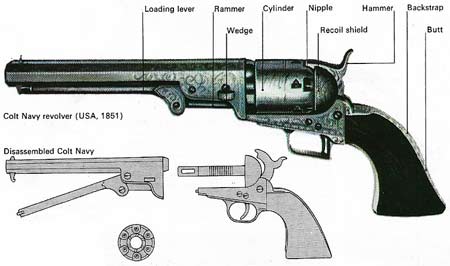
Figure 10. The Colt Navy was not the first of Colt's revolvers, but is probably the most famous percussion revolving pistol. In general appearance it is similar to the larger Dragoon and small Pocket models. The Navy was a "belt" pistol, as distinct from the saddle-holster and pocket pistols, and was open-framed, having no strap over the top of the frame. It had a six-chambered cylinder and was of 0.36-inch caliber. Each chamber was normally loaded from the muzzle with powder and ball (or conical bullet) rammed homed and the nipples primed with percussion caps in readiness for firing.
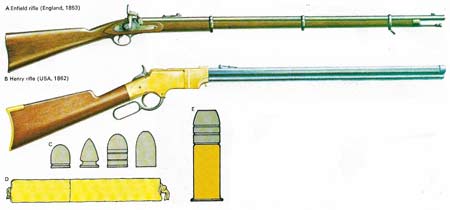
Figure 11. Two popular rifles of the nineteenth century were the 0.57- inch caliber Enfield rifle (A) and the 0.44-inch Henry (B). The Enfield was made in England from 1853; it was a single shot muzzle-loader using a paper cartridge (D) which had to be torn open on loading to expose the powder. It was primed with a percussion cap. Several sorts of bullet for muzzle-loaders are shown (C). The American-made Henry carbine, developed by Tyler Henry, was produced from 1862–1866. It was an early magazine cartridge rifle and the forerunner of the Winchester. It had a tubular magazine beneath the barrel holding fifteen rim-fire cartridges (E), with a sixteenth in the chamber.
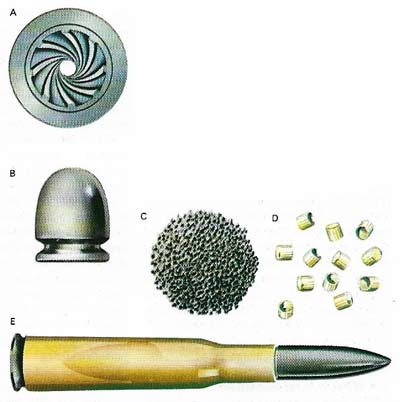
Figure 12. The flight of a bullet is stabilized by spin, caused by grooves (rifling) in the sides of the barrel. Here eight grooves are shown (A). The distance between the grooves is about the diameter of the bullet; the raised "lands" cut into the sides of the bullet, causing it to rotate. Ammunition consists of bullet, charge, and primer, today combined in a metal or plastic case (E). Earlier firearms used separate bullet (B), powder (C), and percussion caps (D). The cap consists of a small charge of sensitive explosive sealed in a cap of metal foil. Struck by the gun's firing pin or hammer, it ignites the main charge.
Firearms, whatever their age, are similar in principle. They consist of a tube or barrel along which a projectile is propelled by an explosion, a means of ignition and a way of controlling the ignition. The development of firearms is marked by improvements to the firing mechanism or "lock", so called because firearm mechanisms or actions were originally made by locksmiths.
Development of ignition systems
The first firearm was the infantry hand cannon. It was merely a tube with a spike at one end on which it could be supported when fired. It was ignited by a glowing match thrust into a hole (called a vent) in the breech (the closed end of the barrel).
The first spring-powered mechanical ignition system was the matchlock (Figure 1) developed in the late 15th century. The arquebus was the earliest matchlock musket. Matchlocks remained in use for over two hundred years, establishing many of the accepted characteristics of the longarm. The first matchlock weapon to be fired from the shoulder was a 16th century arquebus, but the early weapons were massive, often needing a support for aiming (Figure 2). Moreover, loading was slow and dangerous. Powder and a ball were rammed down the barrel from the muzzle, with a wad to hold them in place. Then priming powder (fine gunpowder) was placed in the priming pan – all while the mechanism held the glowing slow-match. These difficulties made the weapon unsuitable for mounted men. Almost all matchlocks were smoothbore (with unrifled barrels), and breech-loaders were rare.
The wheel-lock (Figure 3) was an enormous advance over the matchlock because it could be loaded and held ready for long periods for immediate use. It was invented in the early sixteenth century (many of the finest surviving examples are German (Figure 4)) but was complex, fragile and expensive. Because rich men rode on horseback, the wheel-lock in carbine and pistol (Figure 5) form became the weapon of the horseman. Wheel-locks were favored by German mercenaries (sixteenth century) and English cavalry troops (early 17th century).
The chief need was for a weapon lighter and less cumbersome than the matchlock, yet cheaper and more reliable than the wheel-lock. Both the snaphance and flintlock relied on a flint for ignition. They differed in that the battery or steel (the piece of metal struck by the flint) and pan-cover were one piece on a flintlock (Figure 8), two on a snaphance.
The flintlock soon replaced all other firearms. Muskets such as the Brown Bess and the Charleville, and later rifles such as the Ferguson breech-loader, Jaeger rifle and the Kentucky rifle (Figure 7) have contributed much to the development of firearms and to the histories of nations.
Many inventors had tried to increase firepower by using multi-barreled arms, superimposed charges and other means. But none was really practical and only double-barreled weapons had lasting popularity.
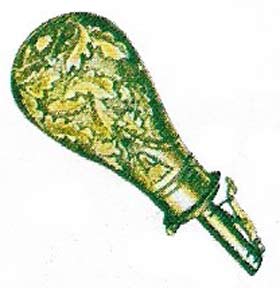 |
| Powder flasks were used until the introduction of cartridge weapons. A pistol flask such as this was designed to measure the charge as well as pour it; such flasks were both easy and safe to use. |
Percussion and the repeating firearm
The Reverend Alexander John Forsyth (1769–1843) began the percussion era in 1805 with his lock that used a highly sensitive explosive called fulminating powder as priming. Like other later devices the lock used the explosive properties of fulminates when struck by a hammer blow as the means of ignition. Of the various percussion ignition systems that followed Forsyth's invention the cap-lock (Figure 9) was the most successful.
At first the general design of weapons did not alter, and many flintlocks were converted to cap ignition. Then in 1835–1836 Samuel Colt (1814–1862) patented his revolving pistol and the repeating firearm had arrived. Even so, Colt's business was not an unqualified success and in 1842 his first venture failed from lack of orders. Then, in 1847, Colt was asked by Captain Walker of the US Dragoons to produce a new weapon of 0.44-inch caliber for military use. This large, six-shot saddle-holster pistol was the "Walker" Colt.
The Walker Colt was followed by other dragoon pistols, the 0.31-inch caliber pocket models, the 0.36-inch Navy (Figure 10) and Police models, the 0.44-inch Army, as well as revolving shotguns, muskets and rifles. Muzzle-loading revolvers can, if badly loaded, occasionally "chainfire", when more than one chamber discharges in succession. Because a longarm is held in both hands, this hazard made revolving longarms unpopular – a right-handed shooter, for example, could shoot off his left hand.
All percussion Colts were "single-action" pistols – that is, the shooter had first to cock the hammer with his thumb. Most were open-frame revolvers and lacked the rigidity of solid-frame pistols.
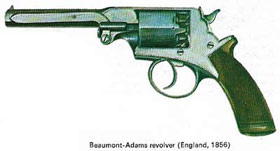 |
| An early double-action revolver was this Beaumont-Adams, developed in England in 1856 from the Adam's self-cocking revolver. Trigger pressure cocked and fired it, or alternatively it could be cocked with the thumb before firing. |
Cartridges and the modern firearm
Cartridges had been used for centuries, but not combining the bullet, the charge and primer. The first successful combined cartridge was made in 1812 and later perfected by the German gunsmith Johann Dreyse (1787–1867) for use with his needle-fire rifle in 1837. In America Daniel Wesson (1825–1906) developed an improved rimfire cartridge in 1856 and a similar cartridge was used in the Henry rifle (Figure 11). In rimfire the primer is sealed in the rim of the cartridge case. Centrefire cartridges (with a central primer) followed, and were used in the 1873 Colt and Winchester. Centrefire is still used for most modern firearms, including machine guns and cannon guns.
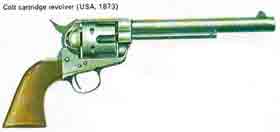 |
| The most famous revolver is the Colt "45", which first appeared in 1873 and is still produced today. A center-fire revolver, it was the first "modern" handgun to be manufactured in quantity for both civil and military use. |
